A potpourri of raptors I’ve photographed within the last two weeks in northern Utah. For varying reasons I think each image has at least some merit.
1/5000, ISO 6.3, ISO 500, Canon 7D Mark II, Canon EF 500mm f/4L IS II USM + EF 1.4 III Extender, not baited, set up or called in
I like this Burrowing Owl photo for its fine detail and the clean look at the bird. For the elevated perch I prefer rustic wooden posts over metal ones but at least this one is old and rusty rather than painted. Side light doesn’t always work for me but in this case I do like the effect.
1/3200, ISO 6.3, ISO 500, Canon 7D Mark II, Canon EF 500mm f/4L IS II USM + EF 1.4 III Extender, not baited, set up or called in
This is a Short-eared Owl giving me the stink-eye. Notice that the perch is an unusually large wooden fence post (corner posts are often massive). Back in the days when I was submitting images to a nature photography critique site (Nature Photographers Network – NPN) images were often seriously dinged when the perch was particularly large compared to the size of the bird.
I suppose their reasoning was that such a large perch distracted from the bird and/or the size scale seemed disproportionate. I guess I’ve never understood that point of view. After all, if the perch is a bush or a tree it would often fill much more of the frame than this. Perhaps the difference for some folks is the old natural vs unnatural perch thing. But personally I have no problem with the size of this fencepost compared to that of the bird. I actually think its size adds some interest somehow…
1/1600, ISO 6.3, ISO 500, Canon 7D Mark II, Canon EF 500mm f/4L IS II USM + EF 1.4 III Extender, not baited, set up or called in
This is a dark morph Swainson’s Hawk casting a pellet (the perch is one of those painted metal posts I don’t like). I was slow on the trigger and very nearly missed the pellet falling at the bottom of the frame. And then like a dummy I stopped my burst thinking the action was over (it wasn’t).
What we see falling is only a small portion of the entire pellet – the rest of it can still be seen in the throat of the hawk. When the rest of the pellet came out I missed catching it falling. This type of behavior often happens very fast and you have to keep your wits about you to capture it. Sadly, I had a momentary lapse…
In this huge crop of the previous (slightly soft) image we can see the pellet a little more clearly.
1/3200, ISO 7.1, ISO 500, Canon 7D Mark II, Canon EF 500mm f/4L IS II USM + EF 1.4 III Extender, not baited, set up or called in
This image of a Turkey Vulture has its problems but I think it’s interesting because of the rather unique look we get at the flight feathers of the left wing.
Usually we see Turkey Vultures in flight high overhead and they often appear to be entirely blackish. In reality their flight feathers are pale and silvery on their ventral surface and the careful observer will use that “two toned” field mark (among other things) to ID the bird in flight. But a vulture in flight is usually backlit so the lighter colored trailing edge of the wing is often missed by the casual observer.
But the left wing primaries of this vulture are strongly lit by direct light so we can clearly see their true contrasting color. This isn’t a view we get of a Turkey Vulture every day so I found the image quite interesting.
Ron
PS – here I’ve counted the Turkey Vulture as a raptor though some might disagree with that classification, partly because they’re strictly carrion eaters and don’t kill prey.


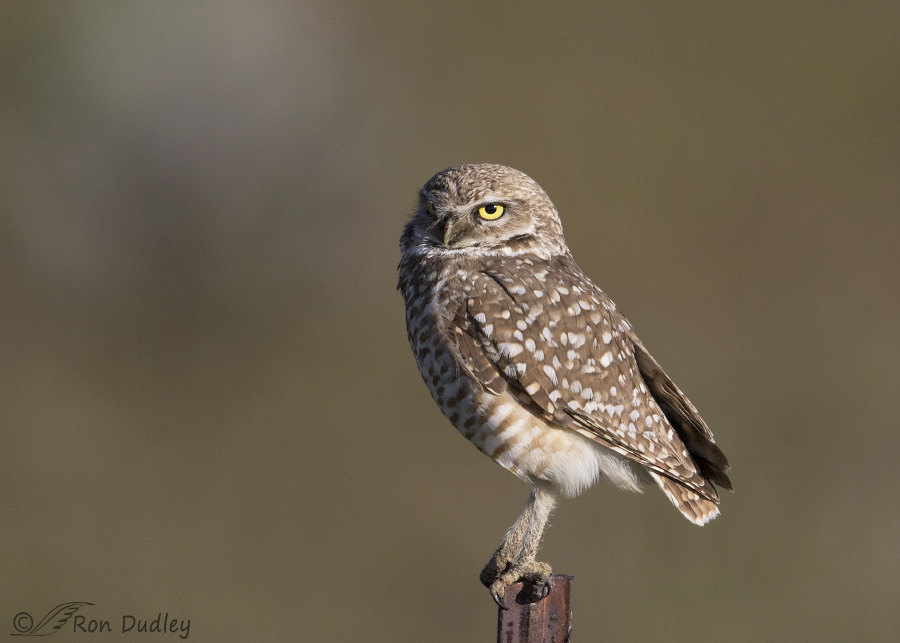
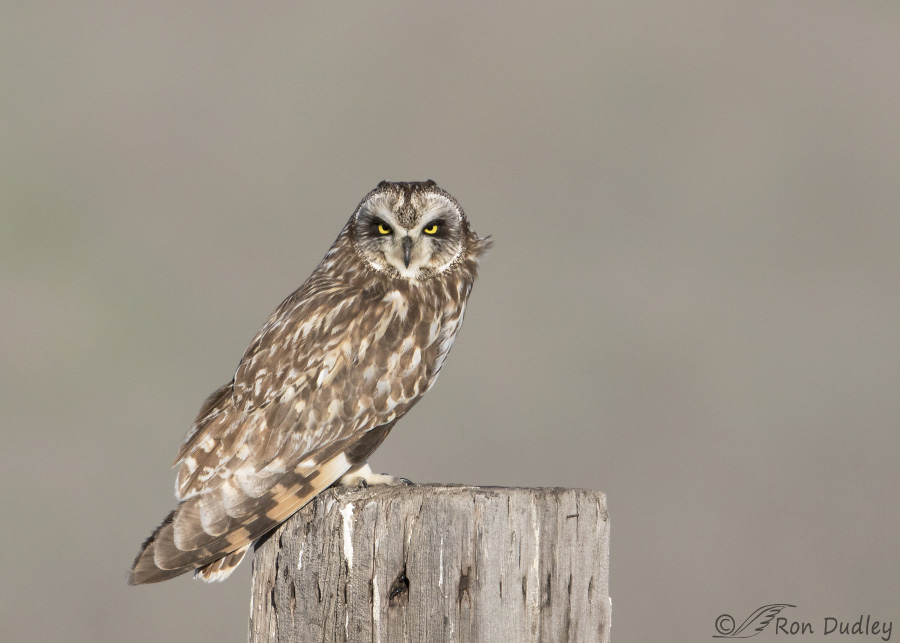
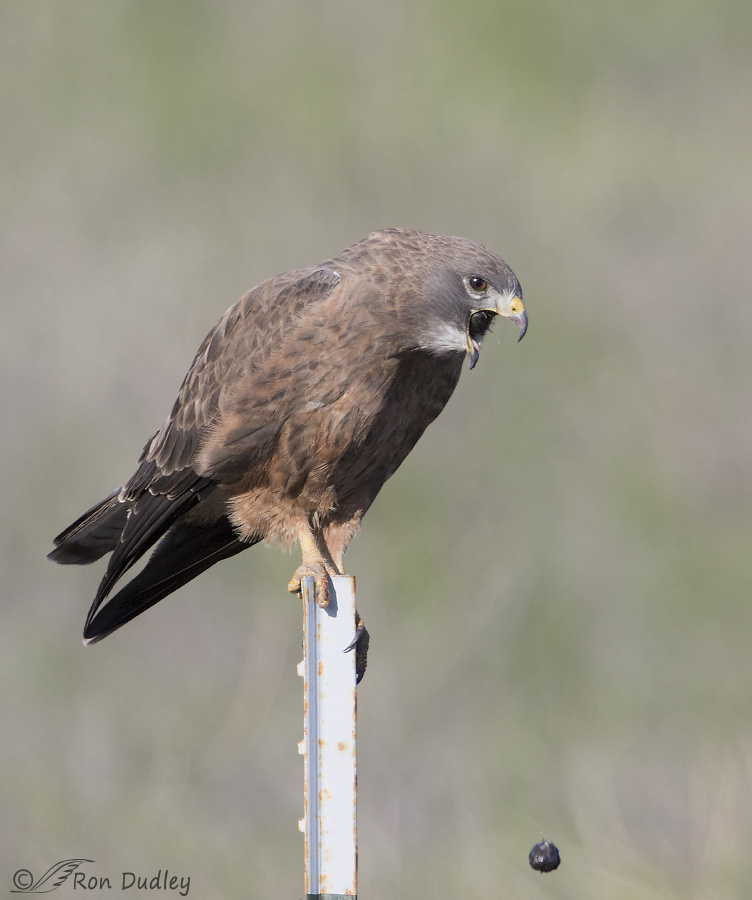
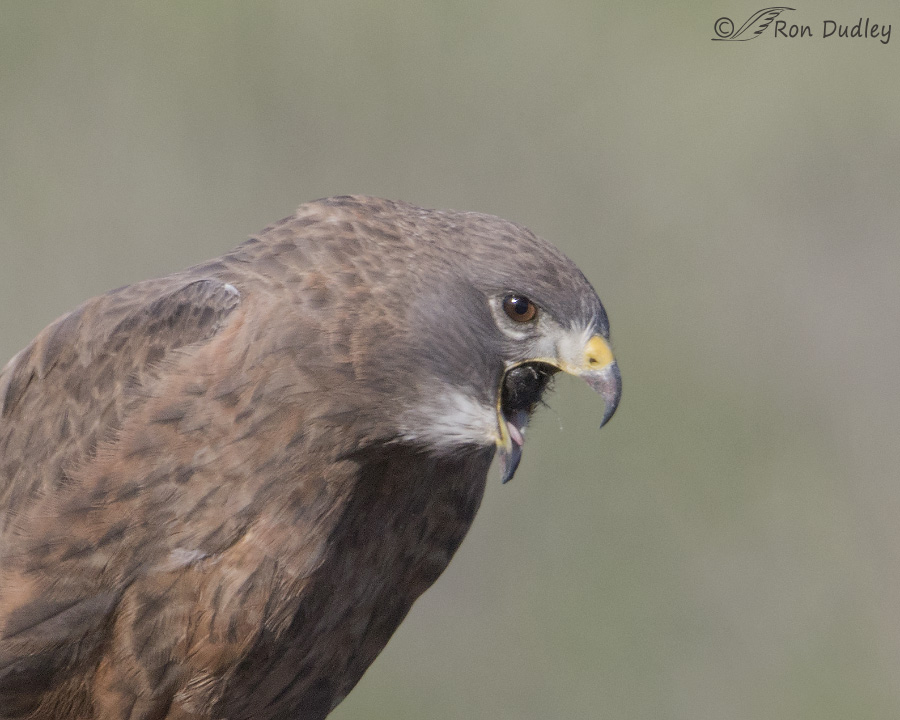
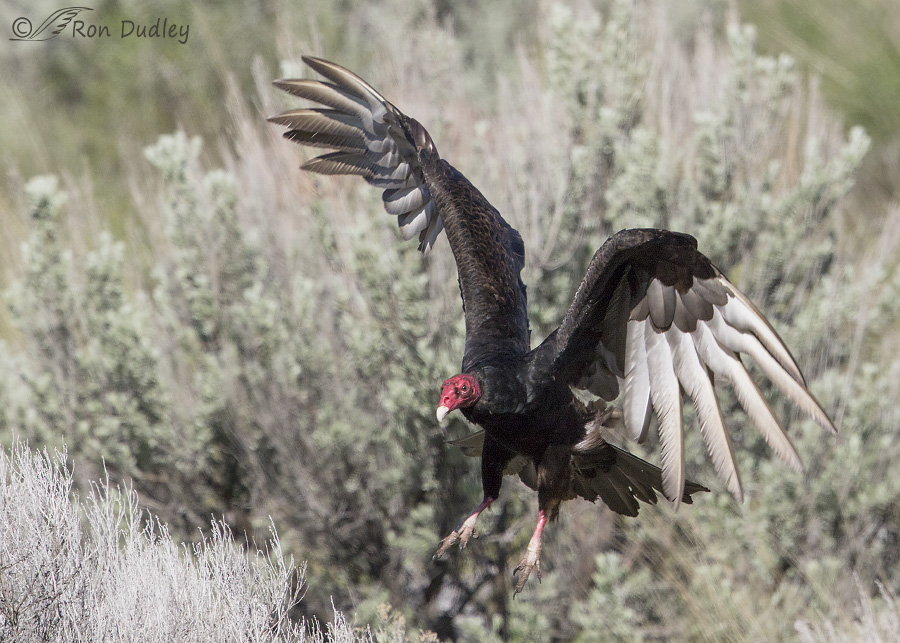
I’ve long been able to distinguish between Black Vultures and Turkey Vultures in flight by the pattern of light color on the ventral surface of their wings, but never knew that the feathers really were lighter colored on that surface. Thank you for the education.
Your raptor post (and I love Marty’s raptourri term) fills me with rapture.
Such magnificent birds. All of them.
I like your “term” too, EC. Thank you.
Gray series Ron and a beautiful array of birds! You are lucky to have such a diverse selection of birds year round. I am particularly fond of owls and have yet to view a burrowing owl in the wild here in Alberta, I have found a few protected areas that state they have burrowing owls as they are an endangered species here after being nearly wiped out by some of the pesticide sprays farmers were using back in the day. Again thank you for sharing
Great*
Mitchell, I’ve also heard from others that their numbers have really plummeted in western Canada. That’s very sad, especially since it’s due at least in part to pesticides. Populations are dropping in many areas down here too but in other areas they seem to be holding their own.
DESPITE that there’s no redtail in this series, what a wonderful way to start my day, which is already slow in getting going. All four images are spectacular! Granted, I have no idea how to properly use a camera, HOWEVER, I know good composition (including all the technical aspects) when I see it. Your photos are always visually appealing to this raptor/bird/critter-phile. LOL!
what a wonderful way to start my day, which is already slow in getting going. All four images are spectacular! Granted, I have no idea how to properly use a camera, HOWEVER, I know good composition (including all the technical aspects) when I see it. Your photos are always visually appealing to this raptor/bird/critter-phile. LOL!
This burrowing owl seems to have dropped the overall cute thing and looks more contemplative and wise.
Personally, I love stink eye (most of the time) unless it’s followed by corrective action that could result in earring opportunities but most certainly bloodletting. I hate bloodletting! The perches almost never bother me at all. In my world, it is what it is out in The Great Out There, and given the primary subject, I’m always drawn there first. There’s a raptor there for pity’s sake. Criticism from other photographers aside, don’t sweat the small stuff! Celebrate the cool stuff instead!
Those whopper castings are amazing! They’re obviously a sign that the bird has eaten well, but JEESH! You gotta wonder how those things make it all the way out!
As for vultures, what can I say other than “YIPPEE!” I love vultures and have a wake of turkey vultures that live here and delight me daily with their fancy soaring. There are an abundant supply of bunnies, jacks and quail here with redtails who dine on them regularly, leaving leftovers. There’s also the inevitable road kills to keep them fed and happy.
Again, thank you for the splendor of The Great Out There!
Thanks for mentioning my composition, Laura. I work at it and don’t always get it right but I do try, quite hard actually.
That you work on the composition aggressively is blatantly obvious! And you’re good at it!
Raptourri! Such a great post (and I’m not just referring to the shortie shot — ba dum tiss)! The shortie must really be in a mood; he’s even showing a bit of his “ear” tuft nubbins. The pellet cast is still a pretty darn cool shot and one most photographers would be thrilled to get, I’m sure.
And I’m trying to find the “problems” of which you speak in the TV shot. I think it is spectacular! The vegetation provides wonderful contrast to the bird and the light play really makes that red head and those naked feet pop! The unusual pose and “reveal” of the primaries adds even more to an already great shot.
I thought of you and Laura yesterday. I was outside at the shelter drying off a Belgian Shepherd that I’d just bathed (he’s a fabulous dog — sweet, playful, and quite the looker!), and was privileged to see one of the resident Red Tails fairly close. He must have caught some air current off the roof because he was low enough for me to see that gorgeous fanned red tail with the daytime moon in the background as he circled a few times. I wish I’d had a camera with me. And a couple extra hands. And any sort of talent in photography.
Today’s “Argyle Sweater” comic features a vulture family. Talk about timing! http://www.gocomics.com/theargylesweater
http://www.gocomics.com/theargylesweater
Marty – the technical shortcomings of that vulture image include shaded belly blacks that show absolutely no detail and the distractingly bright white vegetation at lower left. I brought those whites down during processing so they’re not quite so bad now.
I was mentioning to Mia just this morning how spectacularly beautiful that red tail is in adult red-tails. I’ve seen it many thousands of times but it’s so wonderful that it’s something that I’ll never take for granted or not notice.
Loved the link to the cartoon!
Sunlight filtered through those spectacular red tails is my absolute, double-throw-down, hands-down forever favorite color. Crayola never made that color and they can’t. It’s far too spectacular to be copied by mere humans! Sigh…the beauty!!
I’ve just discovered your blog it’s superb! I was curious on the ethics of falconry and some Google searches regarding that led me to your post about it.
I myself am a photographer in Northern Utah and I’ve never gotten a shot like that of the Turkey Vulture. Absolutely stunning!
It appears that the Swainson’s Hawk is missing a talon on her right foot, that’s interesting. Thanks for sharing these shots!
Welcome to Feathered Photography, Valerie.
Good eye on that possibly missing talon. I usually notice details like that but this one escaped me until you pointed it out.
I like this series..for many reaons…any images of a Burrowing owl or short-earrred is always a good day…the size of the post in the second frame helps us remember how small the short-ears actually are. The flight feathers of the vuiture are especiallyinteresting as are the comments. I once asked someone (Jerry?) what vultures eat when they can’t find carrion and , if I remember correctly, they sometimes eat small rodents, and other small critters…
Patty, based on part of your comment I thought you and perhaps others might be interested in what BNA Online has to say about Turkey Vultures taking live prey:
“Takes live prey occasionally in unnatural situations—e.g., birds that are trapped ( Mueller and Berger 1967b ), captive ( Glading and Glading 1970 , Smith 1982f ), or anesthetized ( Crider and McDaniel 1967 ). In wild, killed live Ruffed Grouse (Bonasa umbellus) chick ( Titus and Mosher 1980 ) and live 10-cm-long fish ( Jackson et al. 1978 ), and one bird was gorged with minnows that may have been taken alive ( Bendire 1892b ). Less well documented attacks on turtle hatchlings ( Fowler 1979 ), sickly domestic fowl ( Scott 1892d ), heron and ibis nestlings ( Brown and Amadon 1968 ) or possibly adults ( Mehner 1951 ), and bird eggs ( Murphy 1936 ). In Ohio, one Turkey Vulture repeatedly attacked 3-wk-old Great Blue Heron nestlings and ate the food they regurgitated, a tactic that may have developed from predatory attacks on nestlings ( Temple 1969 ). Most reported attacks on live animals are attributable to the more aggressive Black Vulture, but some remain uncertain ( Lovell 1952 ).”
Thank you. I hadvalso hesrd that the Bllack vulture, while a bit smaller, is the more aggressive vulture…
Ron, great shots of a variety of raptors! You show variation in feather colors that are often hard to photograph. Do you use the high shutter speed (1/5000th sec.) in some shots for a specific reason or is the camera simply choosing that setting in priority mode. It must be amazing to see so many birds so close to the road that you can simply drive a short distance and get another amazing shot. Great job and thanks for sharing your hard work.
If you get any time to spare, please take a look at my raptor gallery from my regular excursions along the Hudson River in New York.
http://hofferimages.smugmug.com
Reid, I shoot in aperture priority so as soon as my sensor hit this spotlighted Burrowing Owl with that darker background my shutter speed shot up to 1/5000 and I hadn’t yet changed it when I took this shot. It’s definitely faster than ideal but as I’ve explained before on my blog I often deliberately use higher SS’s than most photographers.
A Sunny morning, fresh coffee and Ron’s Raptors. It’s going to be a great day – thanks. I’ve never noticed wing feathers with so much separation before, usually there is more much more overlap as I recall. Interesting.
Thanks, Bill
You’re right about the separation of those wing feathers, Bill – pretty extreme!
Interesting pictures, Ron, I like them all. The two toned ventral coloration on Turkey Vultures is significant. We have a group of TV’s that nest and fly in our area and it is fun watching them soar and use the thermals.
Thanks, Dick. I was mentioning to someone just recently that I’ve never even seen a TV nest. Like to though…
Love your turkey vulture !!!! I love photographing them especially when they are basking in sun to disinfect they’re feathers ! Great shot with good detail of feathers..
Thank you, Marina.
In my relatively brief birding career, New World vultures have, have not and now again have been considered Accipitriformes, cousins of raptors. It’s hard to keep up. If it was a matter of diet, Bald Eagles wouldn’t qualify; three-quarters of their diet is carrion or stolen food. Great shots, though, especially the TUVU.
Thanks, WC. I think the vulture image is my favorite, despite its flaws – just because of the interesting look at the color of the underside of the flight feathers.
Beautiful as usual. I always clip the wings of turkey vultures when they take off or land. Those wings are so long it is hard to adjust.
April, I have the same clipping problem with vultures that you mention. In fact I did it again this morning.
Wow cool shots Ron! So hawks gag up pellets like owls? I did not know that. I am pretty green in all this. The turkey vulture, that is quite a sight! I had a friend email, she said her husband has a pet turkey that happened upon their yard a few weeks before and they feed it like a pet. I thought that was odd, so asked for a photo. I emailed back and said you are feeding a “turkey vulture” hamburger, not a turkey! I said if you croak out on the deck one day I am sure he will take advantage of that! Ha!
Funny!!!
Barby, many birds cast pellets including some songbirds, waders and shorebirds. Loved your turkey/turkey vulture story!
I love it! The turkey vulture in particular is an unusual and a great, in my opinion, shot! Owls are always good and the dark morph Swainson’s is cool even if you didn’t get “the rest of the story”
The turkey vulture in particular is an unusual and a great, in my opinion, shot! Owls are always good and the dark morph Swainson’s is cool even if you didn’t get “the rest of the story”  We have a GHO white fuzz ball peaking over the edge of the nest here this morning – finally. They always seem to be a bit later here than in other areas within 20 miles.
We have a GHO white fuzz ball peaking over the edge of the nest here this morning – finally. They always seem to be a bit later here than in other areas within 20 miles.
So jealous of your GHO nest, Judy. I hope you enjoy the heck out of them!
Wonderful shots Ron!
Charlotte
Thanks, Charlotte.